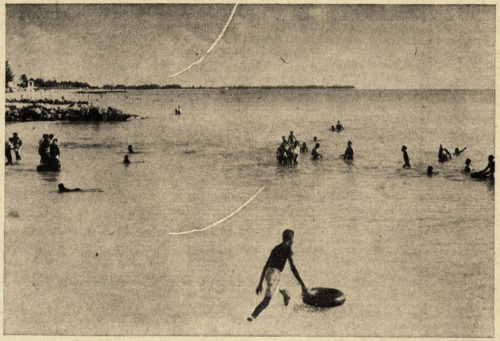by Mandy Polson
February 4, 2018

Clipping from the Sarasota Herald Tribune, October 10, 1955. A group of African Americans swim at the whites-only Lido Beach, Sarasota. Photo courtesy of Sarasota County Historical Resources.
Beaches with white sand and ocean breezes are one of the reasons people choose to live in sunny Florida. Beautiful beaches are enjoyed by tourists and residents alike. However, in the 1950s, African-Americans were unwelcome on many beaches in Florida. Members of Newtown community (the African-American community located north of downtown Sarasota) rallied to right this situation years before Brown vs. the Board of Education or Rosa Parks refusing to give up her bus seat.
While there were no signs posted, or laws on the books, it was understood that black people were not welcome at Lido Beach in Sarasota. In 1951, Newtown resident Mary Emma Jones requested a beach for the “colored” community at a Manatee County Commission meeting. Later that year, a recreation bond issue passed with the promise that some of the money would be used to purchase a public beach for the Newtown community.
Despite many meetings, discussions, and proposals, by 1955 they were no closer to being able to access the beach. During a commission meeting on June 17, it was proposed to the approximately 125 Newtown residents in attendance that instead of purchasing a public beach, a pool and recreation area would be built in Newtown. This proposal was followed by many attendees standing up and letting the commission know that having a pool was not a replacement for having the freedom to visit the beach.
No decision was made at this meeting, and the search for a “suitable” site continued. Tired of the wait, that autumn, Neil Humphrey, president to the local National Association for the Advancement Colored People, organized visits to county-owned Lido Beach. Members of Newtown community carpooled to the beach and went swimming, walked on the beachor sat on the sand. Each visit ended without confrontation. Since visiting the beach wasn’t illegal, they weren’t arrested, but their cars were stopped for vehicle inspections, and “No Parking” signs were strategically placed.
In response to these beach caravans, the county went ahead and built a Newtown swimming pool in 1957. On the day the pool opened, a caravan of Newtown residents headed to the beach.
Though it took many years and much effort from many dedicated people, eventually Sarasota County beaches were desegregated. While there were no announcements made or signs posted, it was understood that black residents were able to visit public beaches. In 2012, a historic marker commemorating this struggle was placed at Lido Pool.
To learn more about our local struggle for equality, visit the Palmetto Historical Park to see the special exhibit Beaches, Benches & Boycotts: The Civil Rights Movement in Tampa Bay. Coinciding with this special exhibit is The Art of the Florida Highwaymen exhibit and, in the Agricultural Museum (located in the Palmetto Historical Park), the Florida’s Black Cowboys: Past and Present exhibit. To learn more about the integration of Manatee County schools from the people who experienced it firsthand, attend the Through the Tunnel: Screening & Panel Discussion.
